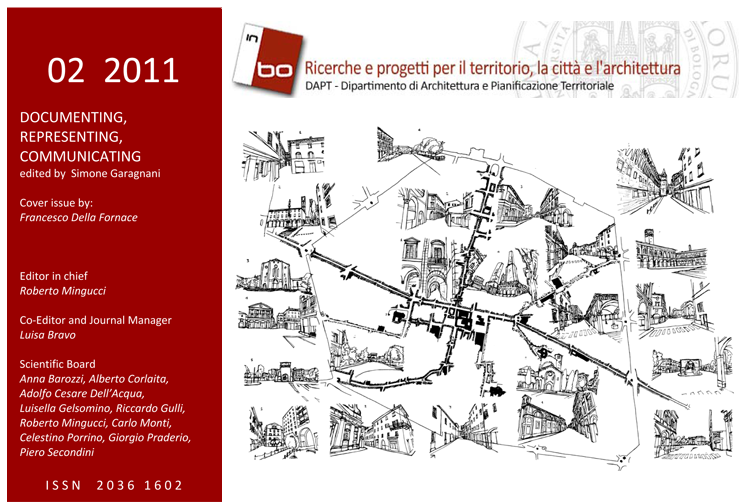People-centered architecture
DOI:
https://doi.org/10.6092/issn.2036-1602/2359Abstract
This paper proposes a humanistic approach to architectural design, which puts people at the center of the designer's thoughts. Understanding how the built environment influences people's behavior, emotions and activities should be the starting point of design. This implies a reflection on the way space can convey meanings – in its denotative and connotative components. Then, the techniques to collect information from the real and supposed users and to include such information in design have been assessed to highlight the advantages and the issues of putting into practice the idea of a people-centered design. The discussion is focused on the supposed loss of autonomy of designers, on the timing of introducing user’s derived data, and on the consequences of including such data in normal design practices.
References
Alexander, R. E. (1989). Architecture, planning, and social responsibility. Oral History Program, University of California, Los Angeles.
Arhippainen, L. (2003). Capturing user experience for product design. Available: www.msh-alpes.prd.fr/ADAMOS/material/arhippa2.pdf [Referenced: 30 Jan., 2010]
Arthur, P., & Passini, R. (1992). Wayfinding: people, signs, and architecture. New York: McGraw-Hill.
Barrett, P. & Stanley, C. (1999) Better Construction Briefing. Oxford: Blackwell Science Ltd.
Beyer H., & Holtzblatt K. (1999). Contextual design, Interactions, 6(1): 32-42.
Boess, S., de Jong, A., Kanis, H., Rooden, M.J. (2008), Investigative Designing: usage-oriented research in and through designing, Undisciplined! Proceedings of the Design Research Society Conference 2008. Sheffield, 2008
Bordass, B. & Leaman, A. (2005), Making feedback and post-occupancy evaluation routine 1: A portfolio of feedback techniques, Building Research & Information (2005) 33(4): 347–352.
Clarke, G. Crossley, P. (Eds.) (2000). Architecture and Language: Constructing Identity in European Architecture, c.1000-c.1650. Cambridge: Cambridge University Press.
Connell, B.R., Jones, M., Mace, R., Mueller, J., Mullick, A., Ostroff, E., Sanford, J., Steinfeld, E., Story, M., Vanderheiden, G. (1997). Universal Design Principles. Center for Universal Design, College of Design, North Carolina State University.
Eco, U. (1980), Function and sign: The Semiotics of Architecture, in Sign. In G. Broadbent, R. Bunt, and C. Jencks (Eds.), Symbols and Architecture. New York: John Wiley and Sons.
Eco, U. (1986), Travels In Hyperreality, New York: Harcourt Brace Jovanovich.
Forty, A. (2000). Words and Buildings: A Vocabulary of Modern Architecture. New York: Thames and Hudson.
Granath, J.A. (2001). Architecture – Participation of users in design activities. Chalmers Tekniska Högskola. Göteborg (http://www.fm.chalmers.se).
Groat, L. & Canter, D. (1979). Does Post-Modemism Communicate? Progressive Architecture. 12:79, 85-86.
Jordan, P. W. (2000). Designing Pleasurable Products. London: Taylor & Francis.
Kyng, M. (1994). Scandinavian Design: Users in Product Development. Proceedings of the SIGCHI conference on Human factors in computing systems: celebrating interdependence, Boston, Massachusetts USA, April 24-28, 1994.
Habermas, J. (1983). Modernity-An Incomplete Project. In H. Foster (Ed.), The Anti-aesthetic: Essays on Postmodern Culture. Seattle: Bay Press.
Hertzberger, H. (2008). Space and Learning. Lessons in Architecture 3. Rotterdam: 010 Publishers.
Hill, R. (1999). Designs and Their Consequences: Architecture and Aesthetics. New Haven, CN: Yale University Press.
Hill, R. (2001). The Use of Architect. Urban Studies, 38(2): 351–365.
Luck, R. (2003). Dialogue in participatory design. Design Studies. 24(6): 523-535.
Mefalopulos, P. & Kamlongera, C. (2004). Participatory communication strategy design: a handbook. Rome: Food and Agriculture Organization of the United Nations (FAO).
Moneo, R. (1986). The Solitude of Buildings. Cambridge, Mass: Harvard University, Graduate School of Design
Passini, R. (1996). Wayfinding design: logic, application and some thoughts on universality. Design Studies, 17(3): 319-331.
Preiser, W.F.E. (1995). Post-occupancy evaluation: how to make buildings work better. Facilities 13(11): 19-28.
Roth, L. M. (1993). Understanding Architecture: Its Elements, History, and Meaning. London: Herbert Press, Ltd.
Sailer, K., Budgen, A., Lonsdale, N., Turner, A., Penn, A., (2008). Evidence-Based Design: Theoretical and Practical Reflections of an Emerging Approach in Office Architecture. Undisciplined! Proceedings of the Design Research Society Conference 2008. Sheffield, 2008
Sanoff, H. (2000). Community Participation Methods in Design and Planning. New York: John Wiley.
Schneider, B. (1999). Daniel Libeskind: Jewish Museum Berlin. New York: Prestel.
Schuman, T. (1991). Forms of Resistance: Politics, Culture, and Architecture. In T. A. Dutton (Ed.), Voices in Architectural Education. Cultural Politics and Pedagogy. New York: Bergin & Garvey.
Vischer, J. (2001). Post-Occupancy Evaluation: A Multifaceted Tool for Building Improvement, Learning from our Buildings: A State-of-the-practice Summary of Post-occupancy Evaluation. Washington, DC: National Academy Press, pp. 23-34.
Vredenburg K. Isensee S. Righi C. (2001). User-Centered Design: An Integrated Approach. Upper Saddle River, NJ: Prentice Hall.
Wilson, F. (1968). Architecture: a book of projects for young adults. New York: Van Nostrand Reinhold.
Zhou, Y. (1996). Cross-cultural significance of connotative meaning in architecture: a comparison of Chinese, British, and American interpretations of meaning in Chinese Gardens. Master's Thesis submitted to the Graduate Faculty of Texas Tech University.
Zimring, C.M. & Reizenstein, J.E. (1980). Post-Occupancy Evaluation: An Overview. Environment and Behavior, 12(4): 429-450.
Downloads
Published
How to Cite
Issue
Section
License
Copyright (c) 2011 Alessandro Rigolon
Copyrights and publishing rights of all the texts on this journal belong to the respective authors without restrictions.
This journal is licensed under a Creative Commons Attribution-NonCommercial 4.0 International License (full legal code).
See also our Open Access Policy.
Metadata
All the metadata of the published material is released in the public domain and may be used by anyone free of charge. This includes references.
Metadata — including references — may be re-used in any medium without prior permission for both not-for-profit and for-profit purposes. We kindly ask users to provide a link to the original metadata record.







